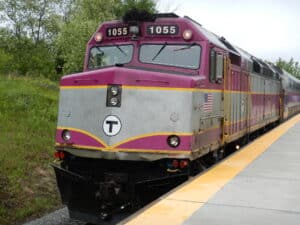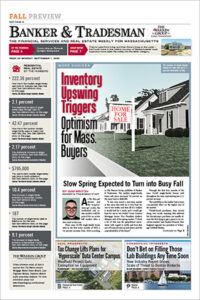
An MBTA commuter rail train waits at a station in 2019. Photo by Paul Morris | Flickr / CC BY-SA 2.0
The state Department of Housing and Community Development has finally released a package of draft guidelines implementing one of the most consequential elements of the Housing Choice law passed in early January.
The “MBTA Communities” portion of the law aimed to force towns in Boston’s suburbs, which have historically blocked multifamily development and affordable housing, to designate areas next to transit service where multifamily buildings can be developed as-of-right. Proponents have argued that adding more transit-oriented zoning in areas served by the MBTA will help address the state’s housing crisis and reduce racial segregation.
DHCD is inviting comment on the draft guidelines. Comments are due by May 5, 2022.
If the proposed regulations go into effect without alterations, towns and cities across nearly all of Central and Eastern Massachusetts will have to designate zoning districts at least 50 acres in size within a half-mile of an MBTA train, subway or major bus station for multifamily development. The entire district, including any commercial areas or parks inside it, must have an overall density of 15 dwelling units per acre – roughly equivalent to densities found in Boston’s three-decker-heavy Dorchester neighborhood or Cambridge’s Central Square.
Towns are explicitly prohibited from complying by zoning particular parcels for particular multifamily projects and from creating overlay districts made up of “a collection of small, non-contiguous parcels.”
The draft guidelines also set out a minimum number of multifamily housing units that can exist as of right within these new multifamily zoning districts, whether new or already developed. This, the guidelines state, is designed to generate more development in less-dense communities.
The total housing units a multifamily district can hold by-right is calculated as a percentage of a community’s total housing stock along a sliding scale depending on the level of transit service a community has. This figure must be based, the guidelines say, on communities’ other zoning limits like setbacks and parking requirements, so a town could not comply by declaring that a skyscraper could be built on a small parcel when building heights are capped at 2.5 stories town-wide.
Under the guidelines, towns and cities will have to come up with an action plan with concrete milestones to create these multifamily zoning districts and get approval from DHCD by spring 2023, and adopt the zoning by the end of 2023 for communities with MBTA subway and bus service, and by the end of 2024 for communities with commuter rail service. Towns and cities will have to recertify their zoning districts every 10 years.
If towns and cities don’t comply, they will lose access to a group of state grant programs, including the MassWorks infrastructure program.






